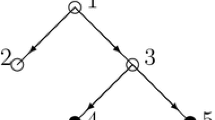Abstract
We consider multi-choice cooperative games with a permission tree structure. Multi-choice games are a generalization of cooperative transferable utility games in which each player has several activity levels. In addition, a permission tree structure models a situation in which a player needs permission from another player to cooperate. In this framework, the influence of a permission structure on the possibility of cooperation may have several interpretations depending on the context. In this paper, we investigate several of these interpretations and introduce for each of them a new allocation rule that we axiomatically characterize.
Similar content being viewed by others
Notes
We continue to denote the sovereign part and the authorizing part of s by \(\sigma (s)\) and \(\alpha (s)\) with the understanding that the underlying permission structure is \(S^+_m\).
References
Albizuri, M. J. (2009). The multichoice coalition value. International Journal of Game Theory, 172(1), 363.
Aumann, R. J., & Dreze, J. H. (1974). Cooperative games with coalition structures. International Journal of Game Theory, 3(4), 217–237.
Béal, S., Lardon, A., Rémila, E., & Solal, P. (2012). The average tree solution for multi-choice forest games. Annals of Operations Research, 196(1), 27–51.
Béal, S., Ferrières, S., & Solal, P. (2022). The priority value for cooperative games with a priority structure. International Journal of Game Theory, 51(2), 431–450.
Branzei, R., Tijs, S., & Zarzuelo, J. (2009). Convex multi-choice games: Characterizations and monotonic allocation schemes. European Journal of Operational Research, 198(2), 571–575.
Calvo, E., & Santos, J. C. (2000). A value for multichoice games. Mathematical Social Sciences, 40(3), 341–354.
Derks, J., & Peters, H. (1993). A Shapley value for games with restricted coalitions. International Journal of Game Theory, 21(4), 351–360.
Dong, B., Ni, D., & Wang, Y. (2012). Sharing a polluted river network. Environmental and Resource Economics, 53(3), 367–387.
Gilles, R. P., Owen, G., & van den Brink, R. (1992). Games with permission structures: The conjunctive approach. International Journal of Game Theory, 20(3), 277–293.
Grabisch, M., & Lange, F. (2007). Games on lattices, multichoice games and the shapley value: A new approach. Mathematical Methods of Operations Research, 65(1), 153–167.
Herings, J.-J., Van Der Laan, G., & Talman, D. (2008). The average tree solution for cycle-free graph games. Games and Economic Behavior, 62(1), 77–92.
Hsiao, C.-R., & Raghavan, T. (1992). Monotonicity and dummy free property for multi-choice cooperative games. International Journal of Game Theory, 21(3), 301–312.
Klijn, F., Slikker, M., & Zarzuelo, J. (1999). Characterizations of a multi-choice value. International Journal of Game Theory, 28(4), 521–532.
Lowing, D., & Techer, K. (2022). Priority relations and cooperation with multiple activity levels. Journal of Mathematical Economics. https://doi.org/10.1016/j.jmateco.2022.102740
Lowing, D., & Techer, K. (2022). Marginalism, egalitarianism and efficiency in multi-choice games. Social Choice and Welfare. https://doi.org/10.1007/s00355-022-01412-8
Myerson, R. B. (1977). Graphs and cooperation in games. Mathematics of Operations Research, 2(3), 225–229.
Ni, D., & Wang, Y. (2007). Sharing a polluted river. Games and Economic Behavior, 60(1), 176–186.
Owen. G. (1977). Values of games with a priori unions. Mathematical economics and game theory, pp. 76–88
Peters, H., & Zank, H. (2005). The egalitarian solution for multichoice games. International Journal of Game Theory, 137(1), 399–409.
Shapley, L. S. (1953). A value for n-person games. Contributions to the Theory of Games, 2(28), 307–317.
van den Brink, R. (2017). Games with a permission structure - a survey on generalizations and applications. TOP, 25(1), 1–33.
van den Brink, R., & Gilles, R. P. (1996). Axiomatizations of the conjunctive permission value for games with permission structures. Games and Economic Behavior, 12(1), 113–126.
van den Brink, R., Herings, J.-J., Van Der Laan, G., & Talman, A. (2015). The average tree permission value for games with a permission tree. Economic Theory, 58(1), 99–123.
van den Brink, R., He, S., & Huang, J.-P. (2018). Polluted river problems and games with a permission structure. Games and Economic Behavior, 108, 182–205.
van den Nouweland, C. G. A. (1993). Games and graphs in economic situations. Tilburg university.
Acknowledgements
We are grateful to an anonymous reviewer for their comments on our work. We also thank Sylvain Béal, Stéphane Gonzalez, Kevin Techer and Philippe Solal for useful comments. We are grateful to Encarnación Algaba and the EURO21 organizing committee for letting us present this paper at the EURO21 conference, Eric Bahel for letting us present this paper at the International Conference on Social Choice and Voting Theory, and the SING16 organizing committee for letting us present this paper at the European Meeting on Game Theory (2021). The author wants to thank GRDF (Gaz Réseau Distribution France) for their financial support through the ANRT (Association Nationale Recherche Technologie) doctoral program CIFRE (Conventions Industrielles de Formation par la REcherche).
Author information
Authors and Affiliations
Corresponding author
Additional information
Publisher's Note
Springer Nature remains neutral with regard to jurisdictional claims in published maps and institutional affiliations.
Rights and permissions
Springer Nature or its licensor holds exclusive rights to this article under a publishing agreement with the author(s) or other rightsholder(s); author self-archiving of the accepted manuscript version of this article is solely governed by the terms of such publishing agreement and applicable law.
About this article
Cite this article
Lowing, D. Allocation rules for multi-choice games with a permission tree structure. Ann Oper Res 320, 261–291 (2023). https://doi.org/10.1007/s10479-022-04953-4
Accepted:
Published:
Issue Date:
DOI: https://doi.org/10.1007/s10479-022-04953-4




